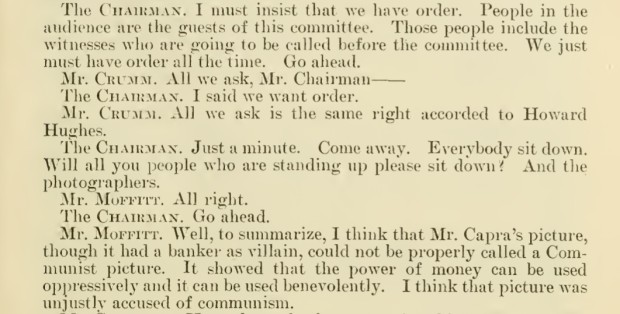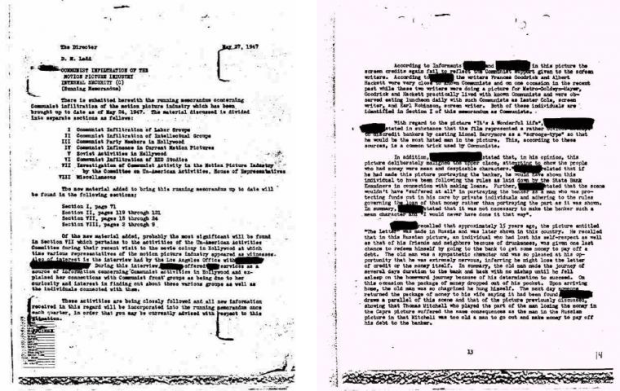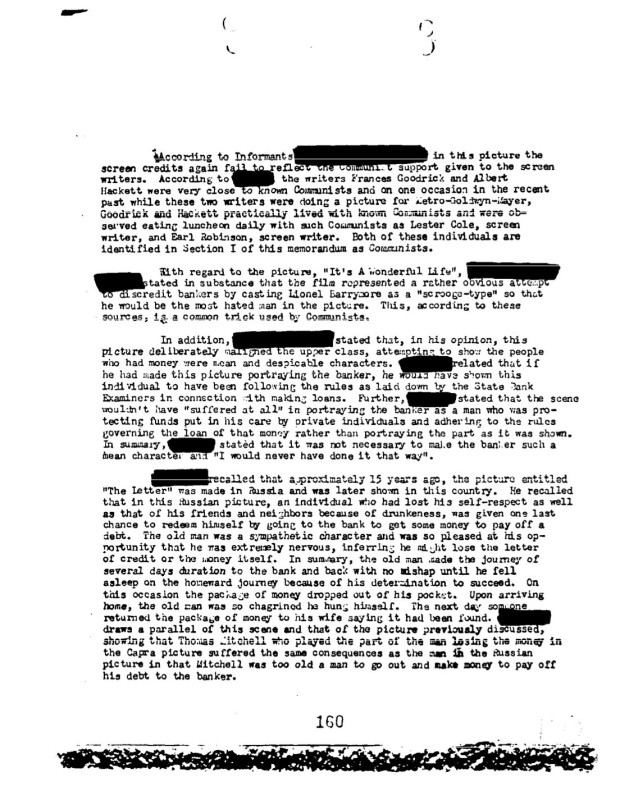An iconographic and text archive related to communication, technology and art.
☛ Federal Bureau of Investigation, file no. 100-HQ-138754 “Communist Infiltration of the Motion Picture Industry” (COMPIC), Part 7 of 15, Serial 251×1, original page 160 (page 67 of the PDF document compic7b.pdf). Click for larger size.
It’s a Wonderful Life (1946) is 11th in AFI’s list of the 100 best American movies ever made. According to Variety, a sequel is said to be in the works (“‘It’s a Wonderful Life’ Sequel in the Works” by Dave McNary, Nov. 18, 2013).

However, for a short while between 1947 and 1956, it was also listed by the Federal Bureau of Investigation under the suspicion of being a vehicle of Communist propaganda. Here, relevant files from the FBI’s archive are provided as well as links to 2,000 pages of excerpts from the “Communist Infiltration of the Motion Picture Industry” document.
• • •
• It’s a Wonderful Life: the FBI files
In his book J. Edgar Hoover Goes to the Movies: The FBI and the Origins of Hollywood’s Cold War, author John Sbardellati introduces the political controversy that once surrounded Frank Capra’s It’s A Wonderful Life :
Frank Capra’s It’s a Wonderful Life (RKO, 1946) pivots on the clash of values between the populism of George Bailey, played of course by James Stewart, and the bottom-line ethics of Henry Potter, played so memorably by Lionel Barrymore. The film is now a perennial holiday classic, and has earned distinction with its inclusion, in 1998, on the American Film Institute’s list of the top one hundred American film (ranking number eleven). But modern-day viewers might be surprised to learn that at the time of its release, It’s a Wonderful Life appeared on another, secret, list of films maintained by the Federal Bureau of Investigation (FBI). Such distinction was earned not because of popularity or artistic merit, but rather because of the bureau’s suspicion that Capra’s movie contained Communist propaganda. (New York: Cornell University Press, 2012, pp. 1-2)
The FBI memorandum concerning Frank Capra’s film It’s A Wonderful Life is actually part of the massive 13,533-page FBI file no. 100-HQ-138754 titled “Communist Infiltration of the Motion Picture Industry” (COMPIC). The entirety of this document is not available online, but excerpts are (see below).
According to John A. Noakes’s detailed analysis of those files, the FBI memorandum concerning Frank Carpa’s movie It’s A Wonderful Life was created on August 7, 1947:
In a report dated 7 August 1947, however, the Los Angeles field office finally proved a review of the content of eight films in general release during 1947, including It’s a Wonderful Life. To determine which films were subversive and to identify the actual subversive content, the Los Angeles field office utilised a report issued by a self-assembled ‘group of motion pictures writers, producers and directors who had been alerted to the common menace within the industry’. This ad-hoc group identified three categories of ‘common devices used to turn non-political pictures into carriers of political propaganda’. Applying these ‘common devices’ to It’s a Wonderful Life, the Los Angeles field office concluded that in at least two ways the film served as a ‘carrier of political propaganda’. (“Bankers and Common Men in Bedford Falls: How the FBI Determined That It’s a Wonderful Life Was a Subversive Movie”, Film History, Vol. 10, No. 3, 1998, p. 314)
Among the group who produced the analytical tools that were used by the FBI in its analysis of It’s a Wonderful Life was Ayn Rand. Later, on October 20, 1947, Ayn Rand would also testified in front of the House Committee on Un-American Activities (more about that in the second section). According to another FBI memo related to “Communist Infiltration of the Motion Picture Industry”, Rand had in fact published a similar report all by herself:
Rand published a booklet which was designed for furnishing information concerning the type of Communist propaganda used in motion pictures. This booklet was distributed to producers and publishers. It is her intention to testify before the House Committee regarding the content of this booklet. (FBI files on Ayn Rand obtained through the Freedom of Information Privacy Acts. Retrieved from PaperlessArchives.com)

As his source, John A. Noakes quotes the microfilm collection edited by Daniel Leab Communist Activity in the Entertainment Undustry; FBI Surveillance Files on Hollywood, 1942-1948 (1991, Reel 3, frame 134). Although the content of the 14 microfilm reels is not yet available online, their accompanying “Guide” is (PDF).
Up to a certain point, the FBI Freedom of Information Act (FOIA) Reading Room was providing a link to an index of 2,008 pages of excerpts from the original “Communist Infiltration of the Motion Picture Industry” (COMPIC) file (the last update is from in June 6, 2001). The FBI FOIA Reading Room website has since moved and the files were apparently taken offline in the process (the new FBI Records: Freedom of Information/Privacy Act website also has an electronic reading room called the Vault, but I could not find the 2,008 pages of excerpts from the COMPIC file). The files are still available on the old FBI FOIA Reading Room website through the Internet Archive Wayback Machine.
The same files have also been uploaded on the Internet Archive. The 2,008 pages excerpts of the FBI “COMPIC” file no. 100-HQ-138754 are divided in 15 parts, spread across 26 PDF documents (about 93MB). All the PDF documents are properly identified and the number of pages each contains is provided as well. The files are also hosted on AboutFacts.net were they were accessible at the time of writing: “FBI Investigation of Motion Picture Industry”.
The group to which Ayn Rand was associated and whose report was used by the FBI to list It’s a Wonderful Life as an instrument for Communist propaganda is discussed on one page in particular, included in Part 7 of 15, Serial 251×1, PDF 7B, of the COMPIC excerpts:

The earliest mention of Capra’s movie It’s a Wonderful I could find in the excerpts available online is from October 11, 19471, in the same PDF document. It is part of a sub-section on the “Analysis of Motion Picture Disclosing Communist Propaganda Therein”, itself included in Section IV: “Communist Influence in Motion Pictures”. In the excerpts provided through the Freedom of Information Act, it spreads on pages 159-160 and corresponds to Part 7 of 15, Serial 251×1 (pages 66-67 of the document compic7b.pdf: page 160 is actually displayed at the beginning of this post). The same analysis (redacted in the very same way) is also reproduced on pages 12 and 13 of Part 9, Serial 1003-part 2 (pages 13-14 of the document compic9a.pdf, see below). The reproduction in Part 9 is slightly more legible.

I made a transcription of the film analysis (a partial transcription was previously shared on Wise Bread).
“IT’S A WONDERFUL LIFE”
Released by RKO Pictures, Inc. on December 19, 1946
Producer — Frank Capra
Director — Frank Capra
Screen play — Frances Goodrick, Albert Hackett, Frank Capra
Cast: Starring — James Stewart, Donna Reed, Lionel BarrymoreAccording to the Informants [REDACTED] in this picture the screen credits again fail to reflect the Communist support given to the screen writer. According to [REDACTED] the writers Frances Goodrick and Albert Hackett were very close to known Communists and on one occasion in the recent past while these two writers were doing a picture for Metro-Goldwyn-Mayer, Goodrick and Hackett practically lived with known Communists as Lester Cole, screen writer, and Earl Robinson, screen writer. Both of these individuals are identified in Section I of this memorandum as Communists.
With regard to the picture “It’s A Wonderful Life”, [REDACTED] stated in substance that the film represented a rather obvious attempt to discredit bankers by casting Lionel Barrymore as “scrooge-type” so that he would be the most hated man in the picture. This, according to these sources, is a common trick used by Communists.
In addition, [REDACTED] stated that, in his opinion, this picture deliberately maligned the upper class, attempting to show the people who had money were mean and despicable characters. [REDACTED] related that if he had made this picture portraying the banker, he wold have shown this individual to have been following the rules as laid down by the State Bank Examiners in connection with making loans. Further, [REDACTED] stated that the scene woundn’t have “suffered at all” in portraying the banker as a man who was protecting funds put in his care by private individuals and adhering to the rules governing the loan of that money rather than portraying the part as it was shown. In summary, [REDACTED] stated that it was not necessary to make the banker such a mean character and “I would never have done it that way”.
[REDACTED] recalled that approximately 15 years ago, the picture entitled “The Letter” was made in Russia and was later shown in this country. He recalled that in this Russian picture, an individual who had lost his self-respect as well as that of his friends and neighbors because of drunkeness, was given one last chance to redeem himself by going to the bank to get some money to pay off a debt. The old man was sympathetic character and was so pleased at this opportunity that he was extremely, inferring he might lose the letter of credit or the money itself. In summary, the old man made the journey of several days duration to the bank and back with no mishap until he fell asleep on the homeward journey because of his determination to succeed. On this occasion the package of money dropped out of his pocket. Upon arriving home, the old man was so chagrined he hung himself. The next day someone returned the package of money to his wife saying it had been found. [REDACTED] draws a parallel of this scene and that of the picture previously discussed, showing that Thomas Mitchell who played the part of the man losing the money in the Capra picture suffered the same consequences as the man in the Russian picture in that Mitchell was too old a man to go out and make money to pay off his debt to the banker.
In the FBI COMPIC file, It’s a Wonderful Life is preceded by a similar analysis of The Best Years of Our Lives (William Wyler, 1946) and followed by that of The Farmer’s Daughter (H.C. Potter, 1947). Other films targeted by this “analysis” include Keeper of the Flame (George Cukor, 1942), The Master Race (Herbert J. Biberman, 1944), The North Star (Lewis Milestone, 1943), Pride of the Marines (Delmer Daves, 1945), A Song to Remember (Charles Vidor, 1945), and a couple of others (see below).

The list was updated until December 31, 1955. In the running memorandum dated from January 3, 1956, it is recommended that the memorandum be discontinued (see FBI file no. 100-HQ-138754, Part 10 of 15, Serial 1103: page 3/130 of compic10a.pdf). This memorandum therefor contains the last update of the “Analysis of Motion Picture Disclosing Communist Propaganda Therein” (which listed new films as well). Again, Frank Capra’s It’s A Wonderful Life is mentioned, but much more briefly (Part 10 of 15, Serial 1103-part 1: page 33/129 of compic10b.pdf). However, this document is hardly legible:

• • •
• It’s a Wonderful Life: the House Committee on Un-American Activities hearings
The so-called “analysis” included in the FBI “Communist Infiltration-Motion Picture Industry” file wasn’t the only place Frank Capra’s movie It’s A Wonderful Life was discussed in relation with communist propaganda. The subject was also raised in October 1947 during the Hearings before the House Committee on Un-American Activities (HUAC) which resulted, among other thing, in the systematic blacklisting of Hollywood artists. The public record of the Hearings Regarding the Communist Infiltration of the Motion Picture Industry (80th Congress, 1st Session, October 1947, Washington: Government Printing Office, 1947) are available on the Internet Archive as well. This time however, It’s a Wonderful Life was presented in a better light.
Many important personalities went to testify in front of the HUAC, including Gary Cooper (on the Oct. 23: pp. 219-225) and Walter E. Disney (on Oct. 24: pp. 280-289). In the FBI file on “Communist Infiltration of the Motion Picture Industry” (COMPIC), those witnesses where categorized as being “friendly”:

Among them was Ayn Rand, who testified on October 20 (pp. 82-91). At the time, she was enjoying a significant success as a writer with her book The Fountainhead published four years earlier: it had already sold 360,000 copies, according to Rand. Since she was also intermittently employed by Hollywood, she appeared in front of the House Committee as an expert witness. She had been asked by Committee investigators H. A. Smith to review the movie Song of Russia (1944; IMDb) in order to determine how it could work as a vehicle for Communist propaganda (see an excerpt on YouTube; for more about Ayn Rand’s testimony, see Ayn Rand and Song of Russia: Communism and Anti-Communism in 1940s Hollywood by Robert Mayhew, 2005).
However, the relevant testimony in regard to Frank Capra’s movie was given On October 21, 1947 by film critic and former screenwriter John Charles Moffitt (pp. 108-128). Moffitt had once belong to the Communist party but had since broke with it. When asked by HUAC Chief Invesigator Robert E. Stripling if Hollywood is in the habit of portraying bankers as villainous character, Moffitt takes the opportunity to try to clear the reputation of Frank Capra’s movie It’s A Wonderful Life: he tries to argue that the film isn’t, in fact a Communist movie. His explanation caused quite a commotion in the audience:
MR. STRIPLING. The term “heavy” has been used here as a designation of the part in which the person is a villain. Would you say that the banker has been often cast as a heavy, or consistently cast as a heavy, in pictures in Hollywood?
MR. MOFFITT. Yes, sir. I think that due to Communist pressure he is overfrequently cast as a heavy. By that I do not mean that I think no picture should ever show a villainous banker. In fact, I would right now like to defend one picture that I think has been unjustly accused of communism. That picture is Frank Capra’s It’s a Wonderful Life. The banker in that picture, played by Lionel Barrymore, was most certainly what we call a “dog heavy” in the business. He was a snarling, unsympathetic character. But the hero and his father, played by James Stewart and Samuel S. Hines, were businessmen, in the building and loan business, and they were shown as using money as a benevolent influence.
THE CHAIRMAN. I must insist that we have order. People in the audience are the guests of this committee. Those people include the witnessess who are going to be called before the committee. We just must have order all the time. Go ahead.
MR. CRUMM. All we ask, Mr. Chairman――
THE CHAIRMAN. I said we want order.
MR. CRUMM.All we ask is the same right accorded to Howard Hughes.
THE CHAIRMAN. Just a minute. Come away. Everybody sit down. Will all you people who are standing up please sit down? And the photographers.
MR. MOFFITT. All right.
THE CHAIRMAN. Go ahead.
MR. MOFFITT.Well, to summarize, I think Mr. Capra’s picture, though it had a banker as villain, could not be properly called a Communist picture. It showed that the power of money can be used oppressively and it can be used benevolently. I think that picture was unjustly accused of communism. (Hearings, pp. 122-123)

• • •
1. Since 2006, two images have circulated online that reproduced two pages from the COMPIC file (see below). One reproduces (most) of the “analysis” from Oct. 11, 1947 (referenced above), while the other is the title page of the “running memorandum” about COMPIC as of May 27, 1947 (page 3/80 of FBI file no. 100-HQ-138754, Part 3 of 15, Serial 157×1, compic3a.pdf).

Because of this association, the FBI memorandum about Frank Capra’s movie It’s A Wonderful Life is often wrongly dated from May 27, 1947. It didn’t exist at that time: the memorandum from May 1947 makes no mention of Capra’s movie. It simply announces the upcoming section ―still to be written― in which the analysis would later be added (“IV. Communist Influence in Motion Pictures”).
The two images (613 x 791px) of the FBI memo pertaining to It’s A Wonderful Life first appeared online on Paperless Archives, where the 2,008-page excerpt of FBI file no. 100-HQ-13875 can be bought on CD-ROM. The first available crawl of the site by the Wayback Machine is from January 4th, 2002 and the images are already there. In December of 2005, a thread on Metafilter linked to the Paperless Archives images as it documented the “subversive” side of Capra’s film: see “It’s A Wonderful Life. It’s A Subversive Film” (Dec. 15, 2006). A few days later, a smaller version (370×480) of the same two images were used to illustrate a post about the FBI report over at Wise Bread: “FBI Considered It’s A Wonderful Life Communist Propaganda” by Will Chen, Dec. 24, 2006; updated Mar. 8, 2012). A transcription of the pages was also provided. The post on Wise Bread, along with a cropped image of the FBI memorandum, was picked up by Boing Boing the same day (Dec. 24, 2006): “Old FBI memo: “It’s a Wonderful Life” is commie propaganda”.↩︎︎
• • •

- By Philippe Theophanidis
- on
- ― Published in Art, Communication, Movies
- Tagged: Ayn Rand, communism, culture, entertainment, FBI, Frank Capra, Hollywood, ideology, industry, Joseph-McCarthy, propaganda

